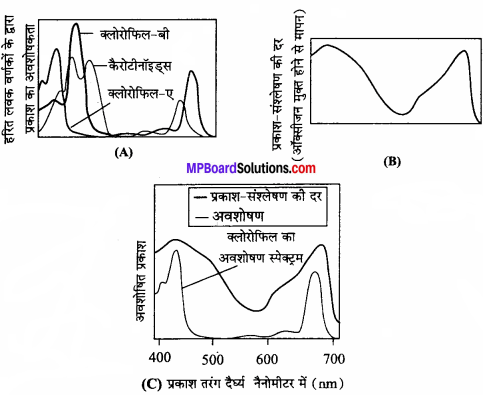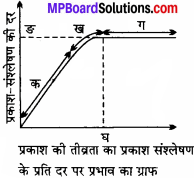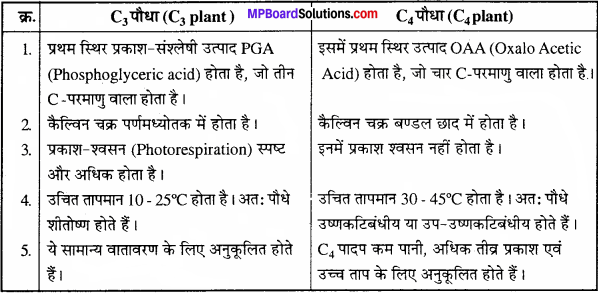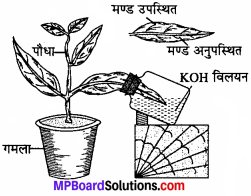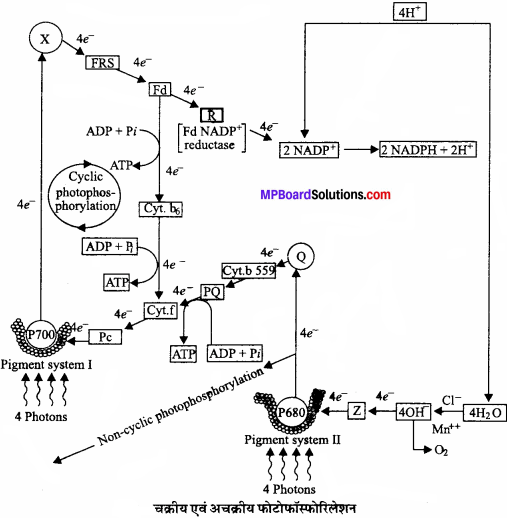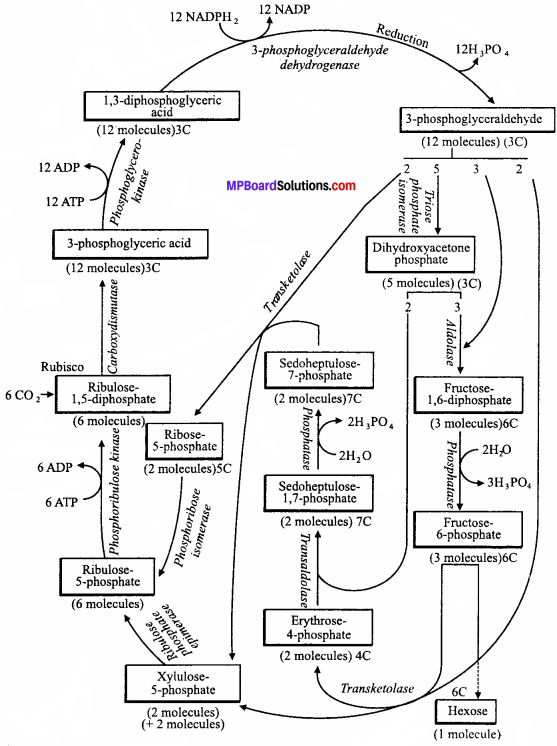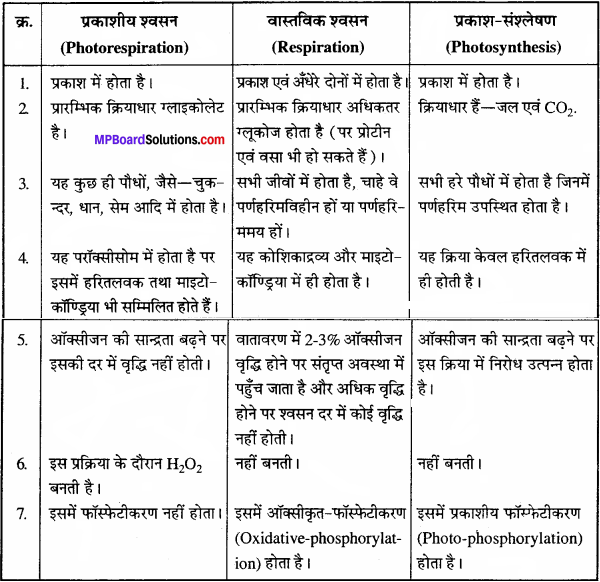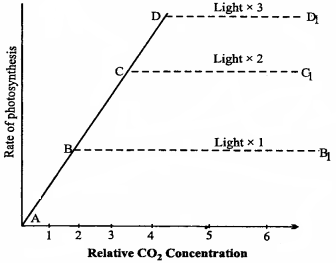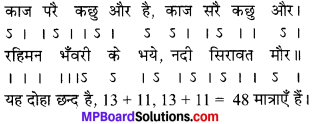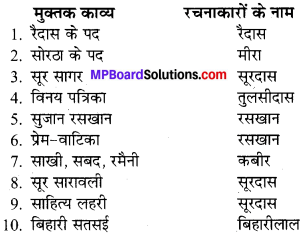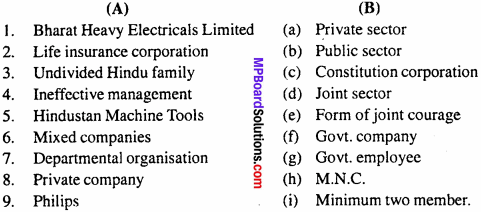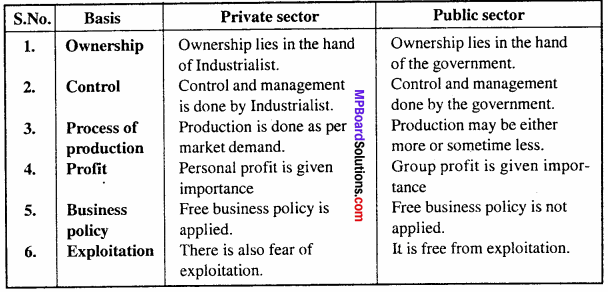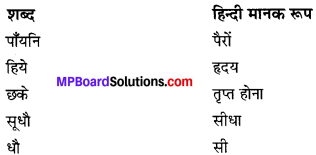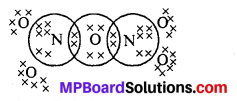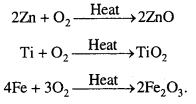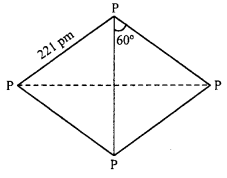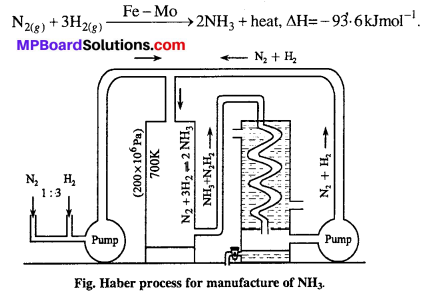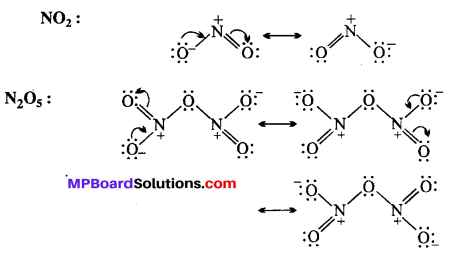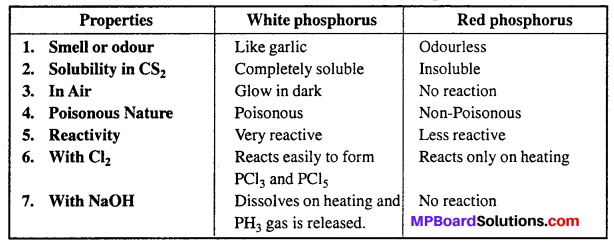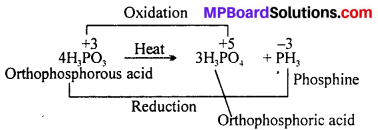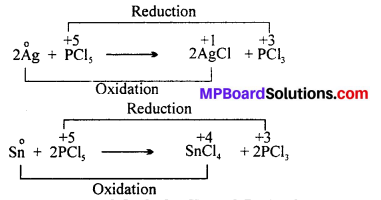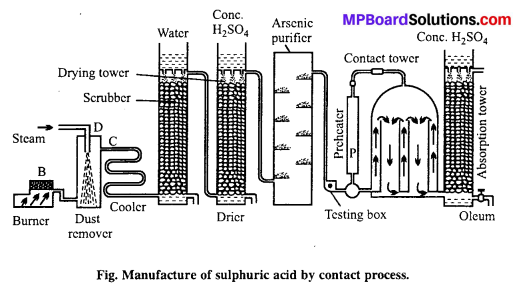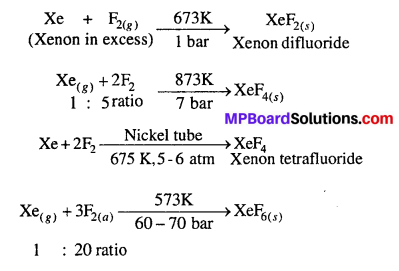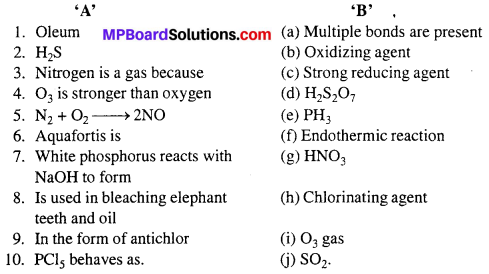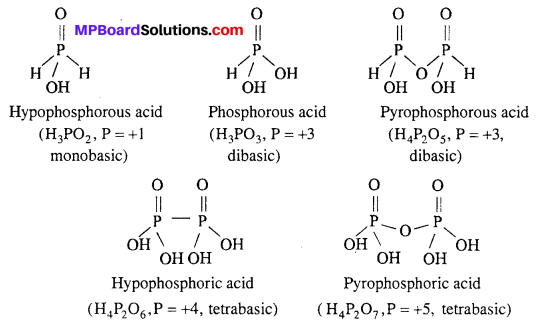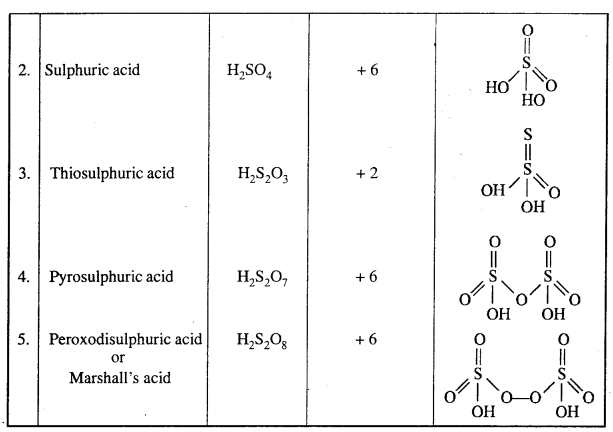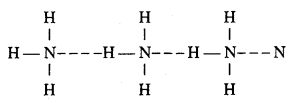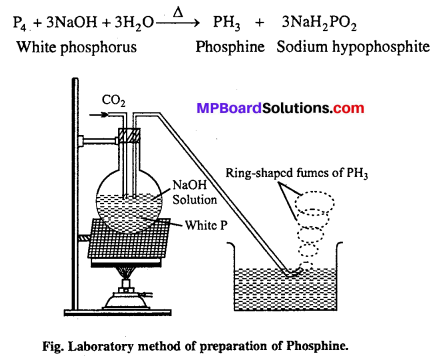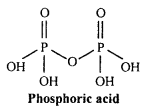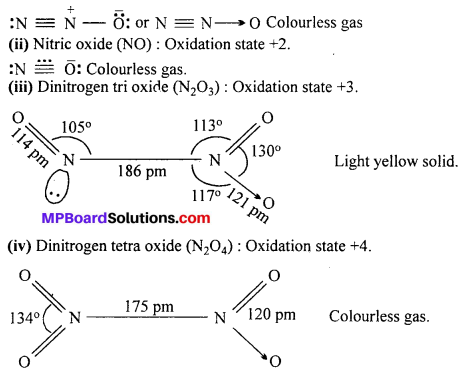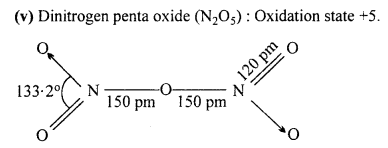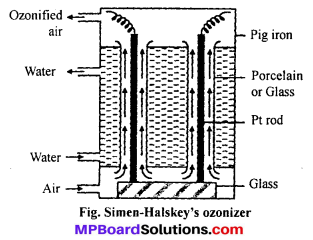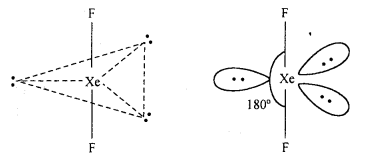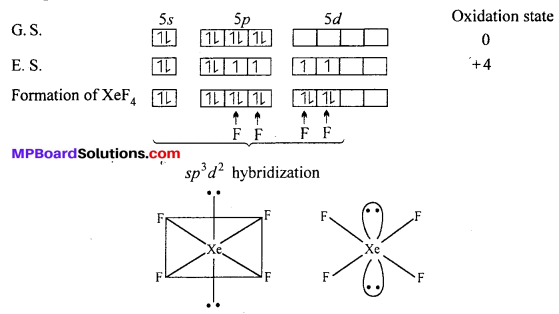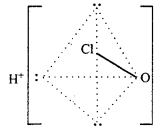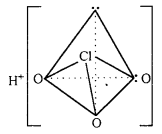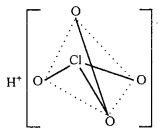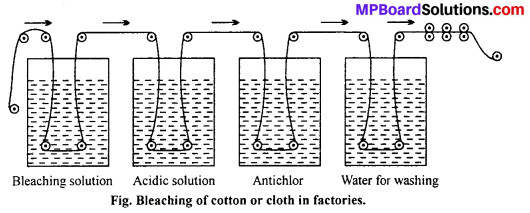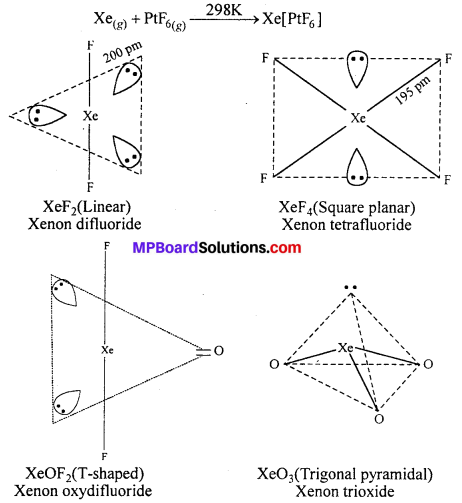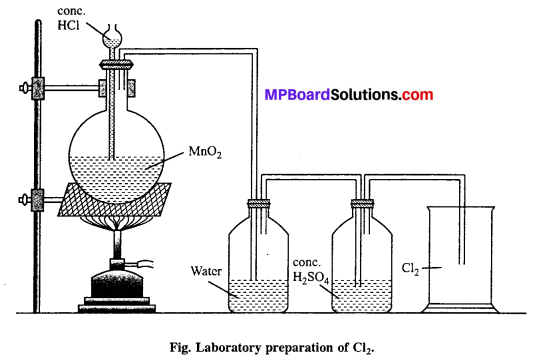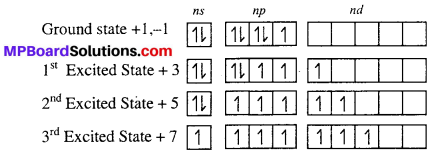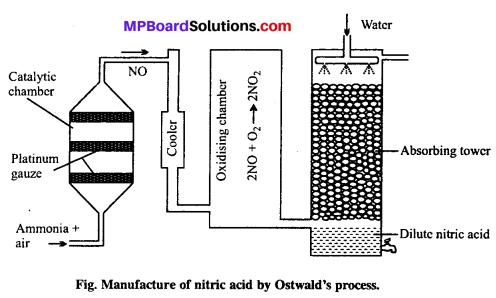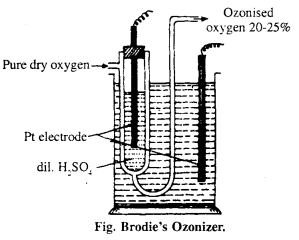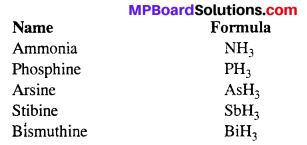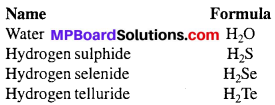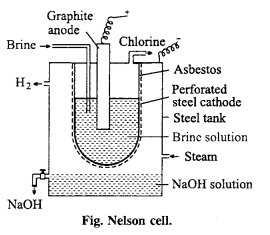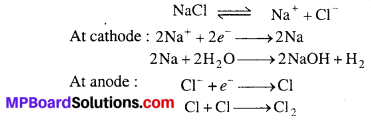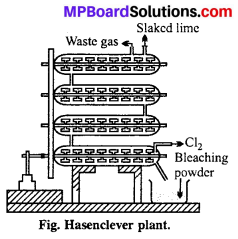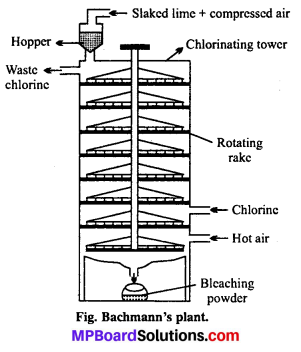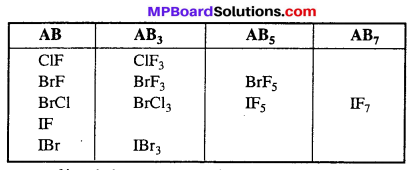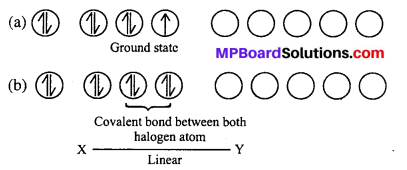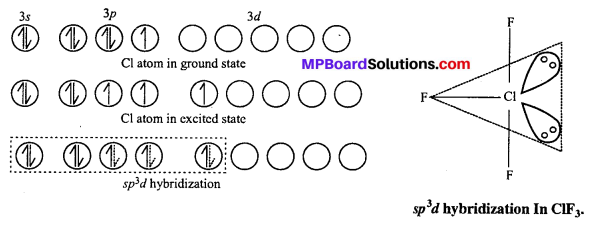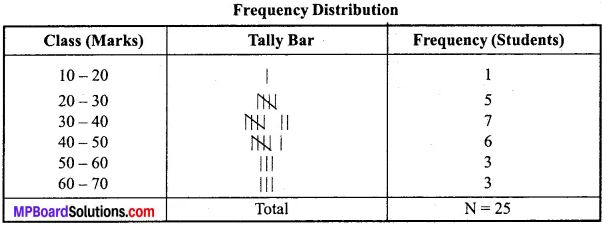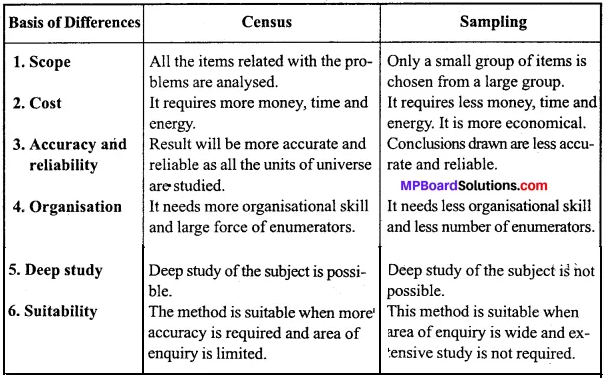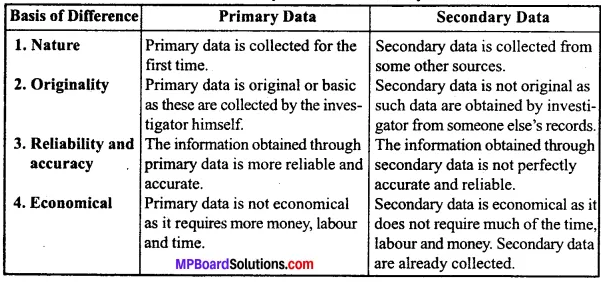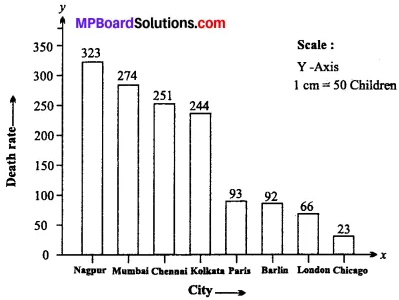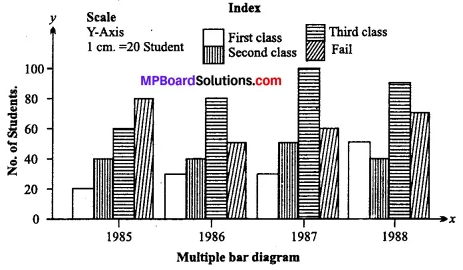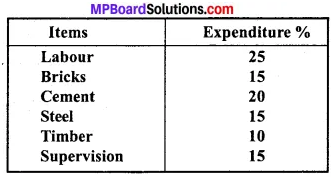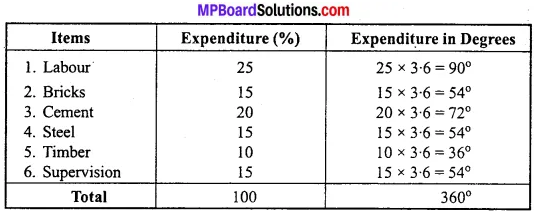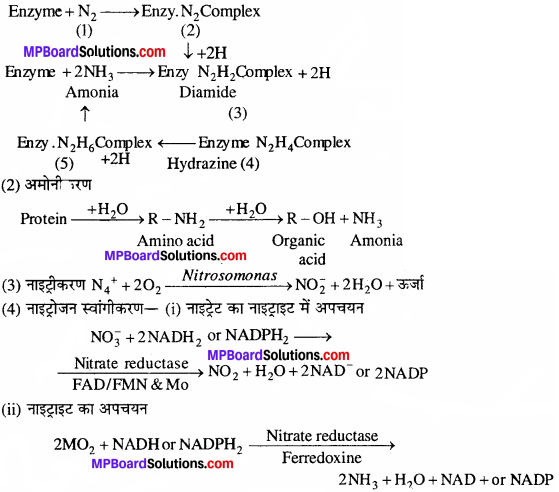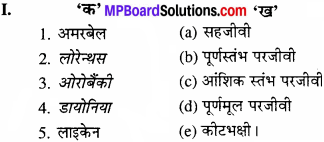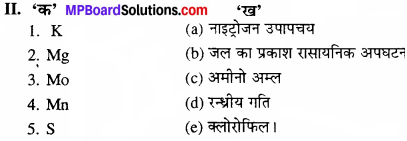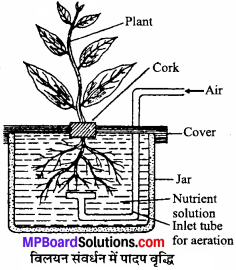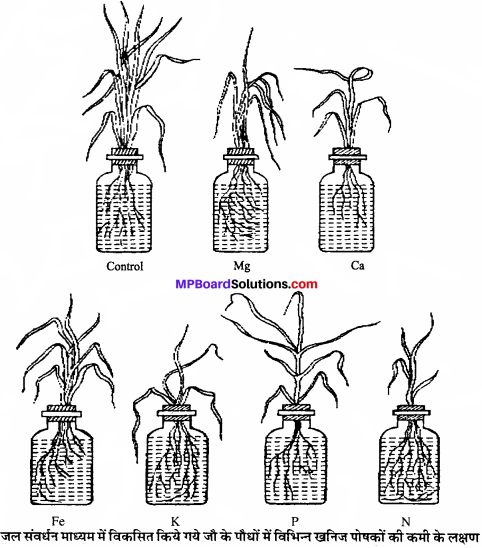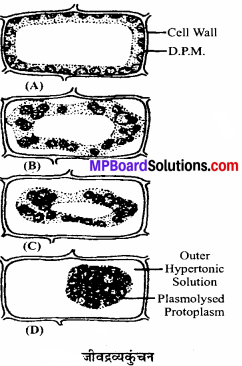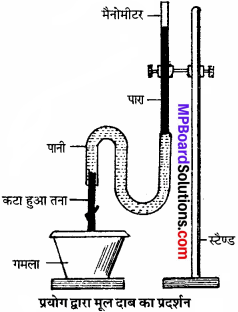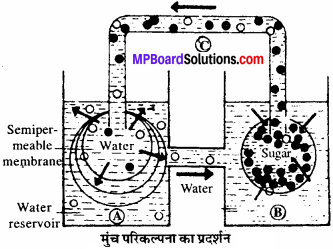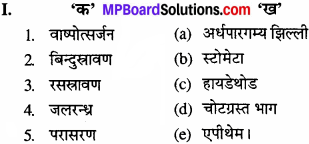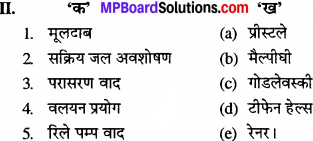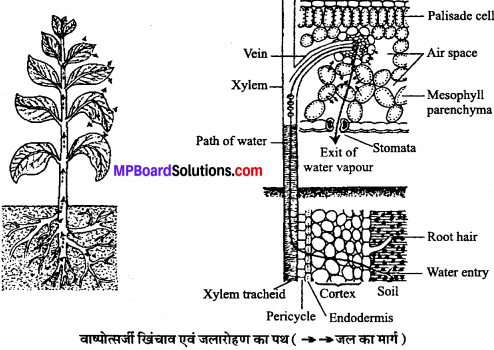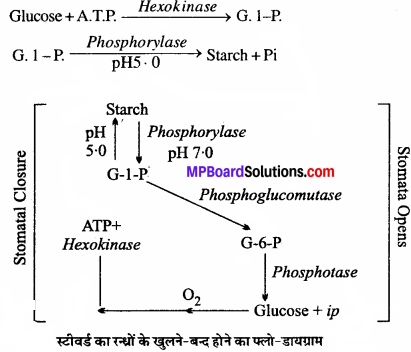MP Board Class 9th Hindi Navneet Solutions पद्य Chapter 5 प्रकृति-चित्रण
प्रकृति-चित्रण अभ्यास
बोध प्रश्न
प्रकृति-चित्रण अति लघु उत्तरीय प्रश्न
प्रश्न 1.
चन्द्रमा की किरणें कहाँ-कहाँ फैली हुई हैं?
उत्तर:
चन्द्रमा की किरणें जल और थल में तथा पृथ्वी से लेकर अम्बर तक फैली हुई हैं।
प्रश्न 2. धरती अपनी प्रसन्नता किस प्रकार प्रकट कर रही है?
उत्तर:
धरती अपनी प्रसन्नता हरी घास के झोंकों में तथा मन्द पवन से फूलने वाली तरुओं के द्वारा प्रकट कर रही है।
प्रश्न 3.
पैसा बोने के पीछे कवि का क्या स्वार्थ था?
उत्तर:
पैसा बोने के पीछे कवि का यह स्वार्थ था कि उससे सुन्दर-सुन्दर पेड़ उगेंगे और फिर वे पेड़ बड़े होकर कलदार रुपयों की फसल उगायेंगे जिन्हें बेचकर कवि एक बड़ा सेठ बन जाएगा।
प्रश्न 4.
कवि ने धरती में क्या बोया?
उत्तर:
कवि ने धरती में सेम के बीज बोये।
प्रश्न 5.
कवि एक दिन अचरज में क्यों भर उठे?
उत्तर:
कवि ने देखा कि एक दिन उनके घर के आँगन में जहाँ कवि ने सेम के बीज बोये थे उनमें से छोटे-छोटे पौधे उग आये हैं। इन्हें देखकर उसे बड़ा अचरज हुआ।
![]()
प्रकृति-चित्रण लघु उत्तरीय प्रश्न
प्रश्न 1.
कवि ने ओस की बूंदों को लेकर क्या कल्पना की है? ‘पंचवटी’ कविता के आधार पर बताइए।
उत्तर:
कवि ने ओस की बूंदों को लेकर यह कल्पना की है कि जब सारे संसार के प्राणी रात में सो जाते हैं तब इस पृथ्वी पर चन्द्रमा ओस रूपी मोतियों को बिखेर देता है। प्रात:काल होने पर सूर्य अपनी किरणों रूपी झाडू से उन सभी मोतियों को बटोर लेता है।
प्रश्न 2.
प्रकृति को नटी क्यों कहा गया है?
उत्तर:
कवि ने प्रकृति को नटी इसलिए कहा गया है कि जिस प्रकार नटी अर्थात् नर्तकी अपने हाव-भाव एवं आंगिक चेष्टाओं द्वारा अपने भावों को व्यक्त करती रहती है। उसी प्रकार प्रकृति भी अपने क्रियाकलापों द्वारा अपनी भावनाओं को व्यक्त कर देती है।
प्रश्न 3.
गोदावरी नदी के तट का मोहक वर्णन कीजिए।
उत्तर:
कवि कहता है कि गोदावरी नदी का यह तट अब भी ताल दे रहा है और उसका चंचल जल कल-कल की ध्वनि में अपनी तान छेड़ रहा है।
प्रश्न 4.
कवि ने किरणों के सौन्दर्य वर्णन में कौन-सी युक्ति अपनाई है?
उत्तर:
कवि ने किरणों के सौन्दर्य वर्णन में यह युक्ति अपनाई है कि जैसे प्रकृति सरल और तरल ओस की बूंदों के द्वारा वह हर्षित होती है तथा विषम समय आने पर वह भी मानव के समान ही रोती है।
प्रश्न 5.
‘सुन्दर लगते थे मानव के हँसमुख मन से’-इस पंक्ति से कवि का क्या अभिप्राय है?
उत्तर:
सेम की श्यामवर्णी बेलों पर सफेद पुष्पों के गुच्छे मनुष्य की उन्मुक्त हँसी के समान लग रहे थे। कवि ने सफेद पुष्पों की तुलना मनुष्य के हँसते हुए मुख से की है।
प्रश्न 6.
कवि की धरती माता के प्रति क्या धारणा बनी?
उत्तर:
कवि धरती माता को उपकार करने वाली, सबका हित करने वाली और बिना किसी लोभ के उनका पालन-पोषण करने वाली मानता है। साथ ही कवि की मान्यता है कि जो व्यक्ति प्रकृति के साथ जितना श्रम करता है धरती माता उसे उतना ही अच्छा फल देती है।
प्रकृति-चित्रण दीर्घ उत्तरीय प्रश्न
प्रश्न 1.
पंचवटी में प्रकृति के उपादानों की शोभा का वर्णन कीजिए।
उत्तर:
पंचवटी में कवि ने प्रकृति के उपादानों के रूप में सूर्य, चन्द्र, हरी घास, तरु, गोदावरी नदी की कल-कल करती हुई जल की तरंगों आदि को प्रस्तुत किया है। रात में चन्द्रमा अपनी शीतल ओस की बूंदों से पृथ्वी को आनन्दित करता है तो प्रात:काल सूर्य उन्हीं बूंदों को साफ कर देता है। पंचवटी में हरी-हरी घास उगी हुई है। घास की कोमल नोंकें पृथ्वी के रोमांच को व्यक्त कर रही हैं। संध्या का समय जगत् के सभी प्राणियों को विश्राम देने वाला बताया है। गोदावरी के जल की कल-कल करती हुई तरंगें मानव मन की खुशी को व्यक्त करने वाली हैं।
प्रश्न 2.
निम्नलिखित काव्यांश की प्रसंग सहित व्याख्या कीजिए
(अ) है बिखेर देती ………….. सवेरा होने पर।
उत्तर:
कविवर गुप्त जी रात्रिकालीन सुषमा का वर्णन करते हुए कहते हैं कि इस समय पृथ्वी सबके सो जाने पर ओस के रूप में अपने मोती बिखेर देती है और प्रात:काल होने पर सूर्य उन्हीं ओस रूपी मोतियों को बटोर लेता है। कहने का भाव यह है कि रात के समय जो ओस घास पर मोती के रूप में चमकती है प्रात:काल सूर्य की गर्मी से वह पिघल जाती है। इस प्रकार विश्राम प्रदान कराने वाली उस अपनी सन्ध्या को वह सूर्य आकाश रूपी श्याम शरीर प्रदान कर उसके रूप को नये रूप में झलका देता है।
(आ) पर बंजर ……….. पैसा उगला।
उत्तर:
कवि कहता है कि जब मैंने बचपन में लोगों से छिपाकर पैसे जमीन में बोये तो उस बंजर भूमि में से पैसों का एक भी कुल्ला नहीं फूटा। उस बाँझ पृथ्वी ने मेरे द्वारा गाड़े गये पैसों में से एक भी पैसा नहीं उपजाया। इस बात को जानकर मेरे सपने जाने कहाँ मिट गये और वे धूल में मिल गये। मैं निराश हो उठा फिर भी बहुत दिनों तक प्रतीक्षा करता रहा कि शायद कभी उनमें कुल्ले फूटें। मैं बालक बुद्धि के अनुसार टकटकी लगाकर पाँवड़े बिछाकर उन रुपयों के उगने की प्रतीक्षा करता रहा। मैं अज्ञानी था, इसी कारण मैंने भूमि में गलत बीज बोये थे। मैंने स्वार्थ की भावना से भूमि में पैसों को बोया था और उन्हें इच्छाओं के तृष्णा रूपी जल से सींचा था।
प्रश्न 3.
मानवता की सुनहली फसल उगाने से कवि का क्या आशय है?
उत्तर:
मानवता की सुनहली फसल उगाने से कवि का यह आशय है कि हमें पृथ्वी पर उत्तम विचारों वाले बीज बोने चाहिए साथ ही हमें उसमें अथक परिश्रम भी करना चाहिए। ऐसा होने | पर उसमें से जो फल निकलेगा उससे समूची मानवता खुश एवं प्रसन्न रहेगी। कहीं पर दुःख-दर्द, अभाव-निराशा एवं बुरे विचार देखने को नहीं मिलेंगे। कहने का भाव यह है कि यदि मनुष्य निस्वार्थ भाव से प्रेम एवं परिश्रम समाज में बाँटता है तो उससे सम्पूर्ण मानवता सुख का अनुभव करेगी।
प्रश्न 4.
“हम जैसा बोयेंगे वैसा ही पायेंगे” कविता के आधार पर कवि का आशय स्पष्ट कीजिए।
उत्तर:
इस कविता में कवि का आशय यह है कि यदि हम अच्छा बीज बोयेंगे तो हमें अच्छे फल मिलेंगे और यदि हम किसी स्वार्थवश बुरे बीज बोयेंगे तो उनका परिणाम भी बुरा मिलेगा। इस कविता में कवि ने जीवन में दो प्रयोग किये। प्रथम प्रयोग उसने बालपन की अज्ञानता में पृथ्वी में पैसे बो कर दिया था जिसमें उसे निराशा मिली, दूसरा प्रयोग उसने सेम के बीज बो कर किया था जिसमें उसे सब ओर खुशी और आनन्द मिला। सेम की बेल पर इतनी फलियाँ उगी कि कवि ने जाने-पहचाने, परिवारी तथा अन्य सभी लोगों को भरपेट खिलाया।
कहने का भाव यह है कि दोष पृथ्वी का नहीं होता है, दोष तो हमारी अपनी भावना का होता है। यदि हमारी भावना शुद्ध, पवित्र एवं परोपकारी है तो उससे जहाँ हमें आनन्द और शान्ति मिलेगी वहीं हम समाज तथा देश का भी भला कर सकेंगे।
![]()
प्रकृति-चित्रण काव्य-सौन्दर्य
प्रश्न 1.
निम्नलिखित काव्य-पंक्तियों में प्रयुक्त अलंकार पहचान कर लिखिए
- मानो झूम रहे हैं तरु भी मंद पवन के झोंकों से।
- चारु चन्द्र की चंचल किरणें खेल रही हैं जल-थल में।
- निर्झर के निर्मल जल में, ये गजरे हिला-हिला धोना।
उत्तर:
- उत्प्रेक्षा अलंकार
- अनुप्रास अलंकार
- पुनरुक्तिप्रकाश तथा मानवीकरण अलंकार।
प्रश्न 2.
निम्नलिखित शब्दों के विलोम शब्द लिखिएसवेरा, शुचि, बूढ़ा, हर्ष।
उत्तर:
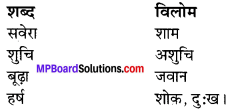
प्रश्न 3.
निम्नलिखित शब्दों के पर्यायवाची शब्द लिखिए
आँख, रवि, धरती, रजनी, फूल।
उत्तर:
आँख – चक्षु, नेत्र।
रवि – दिनकर, सूर्य।
धरती – पृथ्वी, वसुधा।
रजनी – निशा, रात्रि।
फूल – पुष्प, सुमन।
प्रश्न 4.
निम्नलिखित पंक्तियों का भाव-सौन्दर्य स्पष्ट कीजिए
(क) रवि बटोर लेता है, उनको, सदा सबेरा होने पर।
(ख) अति आत्मीया प्रकृति हमारे साथ उन्हीं से रोती है।
उत्तर:
(क) इन पंक्तियों में कवि ने प्रकृति के सौन्दर्य का वर्णन करते हुए कहा है कि रात में चन्द्रमा द्वारा टपकाई गई ओस की बूंदों को प्रात:काल होने पर सूर्य उन्हें बटोर लेता है।
(ख) इन पंक्तियों में कवि ने यह दिखाया है कि प्रकृति मानव के सुख में तुहिन कणों को बिखरा कर हँसती है तो वही प्रकृति दु:ख के समय आत्मीय भाव से अपने उपादानों द्वारा दुःख भाव को भी व्यक्त करती रहती है।
प्रश्न 5.
पाठ में संकलित अंशों से प्रकृति के मानवीकरण के उदाहरण छाँटकर लिखिए।
उत्तर:
- पुलक प्रकट करती है धरती हरित तृणों के झोंकों से।
- है बिखेर देती वसुंधरा, मोती सबके सोने पर।
रवि बटोर लेता है उनको, सदा सवेरा होने पर। - और विरामदायिनी अपनी संध्या को दे जाता है।
- अति आत्मीय प्रकृति हमारे साथ उन्हीं से रोती है।
- रत्न प्रसविनी है वसुधा, अब समझ सका हूँ।
![]()
पंचवटी संदर्भ-प्रसंगसहित व्याख्या
चारु चन्द्र की चंचल किरणें
खेल रही है जल थल में
स्वच्छ चांदनी बिछी हुई है
अवनि और अंबर तल में।
पुलक-प्रकट करती है धरती
हरित तृणों के झोकों से
मानों झूम रहे हैं तरु भी
मंद पवन के झोंकों से। (1)
कठिन शब्दार्थ :
चारु = सुन्दर; थल = स्थल; अवनि = पृथ्वी; अंबर = आकाश; पुलक = प्रसन्नता; हरित तृणों = हरी घास; तरु = वृक्ष; मन्द = धीमी गति से।
सन्दर्भ :
प्रस्तुत पद्यांश श्री मैथिलीशरण गुप्त रचित ‘पंचवटी’ शीर्षक से लिया गया है।
प्रसंग :
इस अंश में कवि ने रात के समय की प्राकृतिक सुषमा का वर्णन किया है।
व्याख्या :
कविवर गुप्त जी कहते हैं कि सुन्दर चन्द्रमा की चंचल किरणें पानी और स्थल पर खेल रही हैं। चन्द्रमा की स्वच्छ चाँदनी आकाश और पृथ्वी पर बिछी हुई है। इस चाँदनी का स्पर्श पाकर मानो पृथ्वी अपनी प्रसन्नता को घास की हरी-भरी नोंकों से प्रकट कर रही है। इस समय वृक्ष भी हवा के मन्द-मन्द झोकों को छूकर मस्त होकर प्रसन्नता से झूम रहे हैं।
विशेष :
- कवि ने प्रकृति का मानवीकरण किया है।
- अनुप्रास एवं उत्प्रेक्षा अलंकार।
- खड़ी बोली का प्रयोग।
क्या ही स्वच्छ चांदनी है यह
है क्या ही निस्तब्ध निशा
है स्वच्छन्द-सुमंद गंध वह
निरानंद है कौन दिशा?
बंद नहीं, अब भी चलते हैं
नियति-नटी के कार्य कलाप
पर कितने एकांत भाव से
कितने शांत और चुपचाप। (2)
कठिन शब्दार्थ :
निस्तब्ध = शान्त; निशा = रात्रि; सुमंद = मन्द-मन्द; गंधवह = सुगन्धि को बहाने वाली; निरानन्द = आनन्द रहित; नियति = भाग्य; नटी = नटनी, आश्चर्यजनक खेल दिखाने वाली।
सन्दर्भ :
पूर्ववत्।
प्रसंग :
इस अंश में कवि ने रात्रिकालीन क्रियाकलापों और प्रकृति नटी के कार्यों का वर्णन किया है।
व्याख्या :
कविवर गुप्त जी कहते हैं कि रात के समय पहरा देते समय प्रकृति की इस सुषमा को देखकर लक्ष्मण जी कहते हैं कि पंचवटी में कितनी सुन्दर और निर्मल चाँदनी फैली हुई है। यहाँ की रात कितनी शान्त है? यहाँ पर स्वच्छ एवं सुगन्धित हवा बह रही है। इस समय यहाँ ऐसी कौन-सी दिशा है जो आनन्द विहीन है? अर्थात् कोई नहीं। इस शान्त वातावरण में प्रकृति नटी के क्रियाकलाप भी चल रहे हैं अर्थात् रात्रि के समय भी प्रकृति के क्रियाकलाप बन्द नहीं हैं। इसके ये क्रियाकलाप कितने अधिक और एकान्त भाव से शान्ति के साथ चुपचाप चलते रहते हैं।
विशेष :
- प्रकृति पर कवि ने नटी का आरोप किया है। अत: रूपक अलंकार।
- प्रकृति का मानवीकरण।
- सहज एवं सरल खड़ी बोली का प्रयोग।
है बिखेर देती वसुंधरा
मोती सबके सोने पर,
रवि बटोर लेता है उनको
सदा सवेरा होने पर,
और विरामदायिनी अपनी
संध्या को दे जाता है,
शून्य श्याम तनु जिससे उसका
नया रूप झलकाता है। (3)
कठिन शब्दार्थ :
वसुन्धरा = पृथ्वी; रवि = सूर्य; विरामदायिनी = विश्राम कराने वाली; शून्य = आकाश; तनु = शरीर।
सन्दर्भ :
पूर्ववत्।
प्रसंग :
कविवर गुप्त जी रात्रिकालीन सुषमा का वर्णन करते हुए कहते हैं कि इस समय पृथ्वी सबके सो जाने पर ओस के रूप में अपने मोती बिखेर देती है और प्रात:काल होने पर सूर्य उन्हीं ओस रूपी मोतियों को बटोर लेता है। कहने का भाव यह है कि रात के समय जो ओस घास पर मोती के रूप में चमकती है प्रात:काल सूर्य की गर्मी से वह पिघल जाती है। इस प्रकार विश्राम प्रदान कराने वाली उस अपनी सन्ध्या को वह सूर्य आकाश रूपी श्याम शरीर प्रदान कर उसके रूप को नये रूप में झलका देता है।
विशेष :
- प्रकृति का मानवीकरण।
- रूपक एवं अनुप्रास अलंकार।
- सहज एवं सरल खड़ी बोली।
![]()
सरल तरल जिन तुहिन-कणों से
हँसती हर्षित होती है,
अति आत्मीया प्रकृति हमारे
साथ उन्हीं से रोती है।
अनजानी भूलों पर भी वह
अदय दण्ड तो देती है
पर बूढ़ों को भी बच्चों सा
सदय भाव से सेती है। (4)
कठिन शब्दार्थ :
तरल = गीले; तुहिन कणों = ओस की बूंदों से; हर्षित = प्रसन्न; आत्मीय = अपनापन दिखाने वाली; अदय = दयाहीन होकर; सद्भाव = दया के भाव से; सेती है = सेवा करती है।
सन्दर्भ :
पूर्ववत्।
प्रसंग :
इस अंश में कवि ने प्रकृति तथा मानव के आत्मीय सम्बन्धों का सुन्दर ढंग से वर्णन किया है।
व्याख्या :
कविवर गुप्त जी कहते हैं कि लक्ष्मण का कथन है कि इस पंचवटी में मानव और प्रकृति के मध्य एक आत्मीय सम्बन्ध है क्योंकि यह प्रकृति मानव के सुख में प्रसन्न और दुःख में दुःखी होती है। सुख का अहसास वह ओस रूपी मोतियों की वर्षा करके तथा दु:ख के समय आँसुओं के समान हमारे साथ रुदन करती हुई दिखाई देती है और यदि किसी से अनजाने में कोई त्रुटि हो जाए तो वही प्रकृति कड़ी से कड़ी सजा भी देती है। इसके साथ ही वह विनम्र भाव से वृद्धों एवं बालकों की समान भाव से सेवा एवं भरण-पोषण भी करती है।
विशेष :
- प्रकृति का मानवीकरण।
- अनुचित कार्य करने वालों को दण्ड की व्यवस्था भी प्रकृति ने कर रखी है।
- अनुप्रास एवं उपमा अलंकार।
- सहज एवं सरल खड़ी बोली।
गोदावरी नदी का तट यह
ताल दे रहा है अब भी,
चंचल जल कल-कल मानो
तान दे रहा है अब भी।
नाच रहे हैं अब भी पत्ते
मन से सुमन महकते हैं
चंद्र और नक्षत्र ललककर
लालच भरे लहकते हैं। (5)
कठिन शब्दार्थ :
तट = किनारा; कल-कल = कल-कल ध्वनि बहते पानी की होती है; सुमन = फूल; लहकते हैं = प्रसन्न होते हैं।
सन्दर्भ :
पूर्ववत्।
प्रसंग :
कवि गोदावरी नदी में बहते जल का वर्णन करते हुए कहता है।
व्याख्या :
कविवर गुप्त जी कहते हैं कि गोदावरी नदी का किनारा अब भी ताल दे रहा है। उसमें बहने वाला चंचल जल अपनी कल-कल ध्वनि से मानो तान दे रहा हो।
आज भी वृक्षों के पत्ते वायु का स्पर्श पाकर नाच रहे हैं तथा वहाँ प्रसन्न मन के समान पुष्प अपनी सुगन्ध बिखेर रहे हैं। यहाँ पर चन्द्रमा और नक्षत्रगण ललककर तथा लालच में भरकर प्रसन्न हो रहे हैं।
विशेष :
- प्रकृति का मानवीकरण।
- अनुप्रास एवं उत्प्रेक्षा अलंकार।
- सहज एवं सरल खड़ी बोली का प्रयोग।
आँखों के आगे हरियाली
रहती है हर घड़ी यहाँ
जहाँ-तहाँ झाड़ी से झरती
है झरनों की झड़ी यहाँ।
वन की एक-एक हिमकणिका
जैसी सरस और शुचि है
क्या सौ-सौ नागरिकजनों की
वैसी विमल रम्य रुचि है। (6)
कठिन शब्दार्थ :
घड़ी = पल; झड़ी = पंक्ति; हिमकणिका = ओस की बूंदें; शुचि = पवित्र; विमल = स्वच्छ; रम्य = रमणीक; रुचि = इच्छा।
सन्दर्भ :
पूर्ववत्।
प्रसंग :
इस अंश में कवि ने प्रकृति के अलौकिक एवं पवित्र सौन्दर्य का वर्णन किया है।
व्याख्या :
कविवर गुप्त जी कहते हैं कि उस पंचवटी में लक्ष्मण जी सोच रहे हैं कि यहाँ प्रतिपल नेत्रों के सामने हरियाली खड़ी रहती है तथा इस वन प्रदेश में जहाँ-तहाँ झाड़ियों के मध्य झर-झर करते हुए सुन्दर झरने प्रवाहित हो रहे हैं।
इस वन प्रदेश का एक-एक कण सरस एवं पवित्र है। वे मन में सोचते हैं कि जितनी पवित्रता एवं सरसता इन ओस के कणों में निहित है क्या उतनी ही पवित्रता एवं सरसता नगर में रहने वाले नागरिकों में देखने को मिलती है? अर्थात् नहीं। क्या नागरिकों के हृदय में भी प्रकृति के सदृश सुन्दर एवं पवित्र भावनाएँ पाई जाती हैं? अर्थात् नहीं पाई जाती हैं। कहने का भाव यह है कि कवि चाहता है कि मानव का मन भी प्रकृति के समान पवित्र होना चाहिए।
विशेष :
- कवि ने मानव में सद्विचारों की कामना की है।
- प्रकृति का मानवीकरण।
- उदाहरण अलंकार।
- सहज एवं सरल खड़ी बोली।
![]()
आः धरती कितना देती है! संदर्भ-प्रसंगसहित व्याख्या
मैंने छुटपन में छिपकर पैसे बोए थे,
सोचा था, पैसों के प्यारे पेड़ उगेंगे,
रुपयों की कलदार मधुर फसलें खनकेंगी,
और फूल-फल कर मैं मोटा सेठ बनूँगा। (1)
कठिन शब्दार्थ :
छुटपन = बचपन में; कलदार = रुपये का खनकता हुआ सिक्का।
सन्दर्भ :
प्रस्तुत पंक्तियाँ ‘आ: धरती कितना देती है’ शीर्षक कविता से ली गयी है। इसके रचयिता श्री सुमित्रानन्दन पंत हैं।
प्रसंग :
इसमें कवि ने अपने बचपन की एक घटना का वर्णन किया है।
व्याख्या :
कविवर सुमित्रानन्दन पन्त जी कहते हैं कि मैंने बचपन में बाल सुलभ स्वभाव के अनुसार लोगों से छिपाकर जमीन में कुछ पैसे गाड़ दिये थे। पैसों के गाड़ने के पीछे भावना यह थी कि पथ्वी में जो भी बोया जाता है वह अगणित रूप में उपज कर हमें सम्पन्न करता है। कवि ने सोचा कि एक-दिन निश्चय ही पैसों के पेड़ उगेंगे और फिर उन पेड़ों से रुपयों की कलदार खनक सुनाई देगी और इस तरह मैं एक बड़ा धनपति अर्थात् सेठ बन जाऊँगा।
विशेष :
- कवि ने बाल सुलभ भावना का वर्णन किया है।
- अनुप्रास अलंकार।
- सहज एवं सरल खड़ी बोली का प्रयोग।
पर बंजर धरती में एक न अंकुर फूटा,
बंध्या मिट्टी ने न एक भी पैसा उगला!
‘सपने जाने कहाँ मिटे, कब धूल हो गये!
मैं हताश हो, बाट जोहता रहा दिनों तक,
बाल-कल्पना के अपलक पाँवड़े बिछाकर!
मैं अबोध था, मैंने गलत बीज बोये थे,
ममता को रोपा था, तृष्णा को सींचा था! (2)
कठिन शब्दार्थ :
बंजर = अनुपजाऊ भूमि; अंकुर = कुल्ला; बंध्या = बाँझ; उगला = पैदा किया; धूल हो गये = मिट्टी में मिल गए; हताशा = निराशा; बाट जोहता रहा = प्रतीक्षा करता रहा; अपलक = बिना पलक झपकाए, टकटकी लगाकर; पाँवड़े = पैरों के नीचे बिछाया जाने वाला वस्त्र; अबोध = अज्ञानी; ममता = मोह; रोपा था = पौधा लगाया था; तृष्णा = प्यास।
सन्दर्भ :
पूर्ववत्।
प्रसंग :
प्रस्तुत अंश में कवि अपने बचपन की अज्ञानता का वर्णन कर रहा है।
व्याख्या :
कवि कहता है कि जब मैंने बचपन में लोगों से छिपाकर पैसे जमीन में बोये तो उस बंजर भूमि में से पैसों का एक भी कुल्ला नहीं फूटा। उस बाँझ पृथ्वी ने मेरे द्वारा गाड़े गये पैसों में से एक भी पैसा नहीं उपजाया। इस बात को जानकर मेरे सपने जाने कहाँ मिट गये और वे धूल में मिल गये। मैं निराश हो उठा फिर भी बहुत दिनों तक प्रतीक्षा करता रहा कि शायद कभी उनमें कुल्ले फूटें। मैं बालक बुद्धि के अनुसार टकटकी लगाकर पाँवड़े बिछाकर उन रुपयों के उगने की प्रतीक्षा करता रहा। मैं अज्ञानी था, इसी कारण मैंने भूमि में गलत बीज बोये थे। मैंने स्वार्थ की भावना से भूमि में पैसों को बोया था और उन्हें इच्छाओं के तृष्णा रूपी जल से सींचा था।
विशेष :
- बाल स्वभाव का वर्णन किया है।
- अनुप्रास, रूपक, उत्प्रेक्षा अलंकार।
- पाँवड़े बिछाना, बाट जोहना मुहावरों का प्रयोग।
अर्धशती हहराती निकल गई है तब से!
कितने ही मधु पतझर बीत गए अनजाने,
ग्रीष्म तपे, वर्षा झूली, शरदें मुसकाईं,
सी-सी कर हेमंत कॅपे, तरु झरे, खिले वन!
ओ’ जब फिर से गाढ़ी ऊदी लालसा लिए,
गहरे कजरारे बादल बरसे धरती पर। (3)
कठिन शब्दार्थ :
अर्धशती = पचास वर्ष; मधु = बसन्त ऋतु; हहराती = गूंजती हुई; कजरारे = काले।
सन्दर्भ :
पूर्ववत्।
प्रसंग :
कवि का कथन है कि रुपये बोने की उस घटना को लगभग पचास वर्ष बीत गये हैं अनेक ऋतुएँ आयीं और चली गईं पर पैसों में कुल्ला नहीं फूटा।
व्याख्या :
कविवर पन्त कहते हैं कि जब बचपन में मैंने रुपये बोये थे तब से लेकर अब तक पचास वर्ष गूंजते हुए निकल गये। इस बीच में अनेक ऋतु परिवर्तन हुए। बसन्त आया, पतझर बीता, ग्रीष्म तपी, वर्षा की झड़ी लगी, शरद ऋतु मुस्कराई, सी-सी करता हुआ एवं काँपता हुआ हेमंत भी आया, वृक्ष झड़ उठे, वन उपवन खिल उठे। मेरे मन में फिर से गाढ़ी ऊदी लालसा लिए हुए घने काले बादल भी पृथ्वी पर आकर वर्षा करते रहे। पर परिणाम कुछ नहीं निकला।
विशेष :
- प्रकृति की विभिन्न ऋतुओं का संकेत रूप में कवि ने चित्रण किया है।
- अनुप्रास अलंकार।
- सहज एवं सरल खड़ी बोली।
![]()
मैंने कौतुहल वश, आँगन के कोने की
गीली तह को ही उँगली से सहलाकर,
बीज सेम के दबा दिए मिट्टी के नीचे!
भू के अंचल में मणि माणिक बाँध दिए हों!
मैं फिर भूल गया इस छोटी-सी घटना को
और बात भी क्या थी, याद जिसे रखता मन! (4)
कठिन शब्दार्थ :
कौतुहलवश = जिज्ञासा से; गीली = भीगी; तह = नीचे की मिट्टी को; अंचल = आँगन।
सन्दर्भ :
पूर्ववत्।
प्रसंग :
कवि बचपन की एक अन्य घटना का वर्णन करते हुए कह रहा है।
व्याख्या :
कविवर पन्त कहते हैं कि मैंने जिज्ञासा के वशीभूत होकर आँगन के एक कोने में गीली मिट्टी को उँगली से कुरेदकर उसमें सेम के बीज बो दिए। उस समय मैंने ऐसा अनुभव किया मानो मैंने पृथ्वी के आँचल में मणि और माणिक बाँध दिये हों। इसके पश्चात् मैं इस छोटी सी बचपन की घटना को भूल गया और वास्तव में बात भी कोई ऐसी विशेष नहीं थी जिसे मैं अपने मन में धारण रखता।।
विशेष :
- बचपन की घटना का वर्णन कवि ने किया है।
- अनुप्रास एवं उत्प्रेक्षा अलंकार।
- सहज एवं सरल खड़ी बोली।
फिर एक दिन, जब मैं संध्या को आँगन में
टहल रहा था- जब सहसा मैंने जो देखा,
उससे हर्ष-विमूढ़ हो उठा मैं विस्मय से!
देखा, आँगन के कोने में कई नवागत
छोटे-छोटे छाता ताने खड़े हुए हैं। (5)
कठिन शब्दार्थ :
संध्या = शाम; सहसा = अचानक; हर्ष-विमूढ़ = खुशी से आनन्दित; विस्मय = आश्चर्य; नवागत = नये आये हुए।
सन्दर्भ :
पूर्ववत्।
प्रसंग :
कवि द्वारा बोये गये सेम के बीजों से जब कुल्ला फूटकर नये-नये पौधे उग आये, उसी का यहाँ वर्णन है।
व्याख्या :
कवि कहता है कि एक दिन शाम के समय जब मैं आँगन में टहल रहा था। तब मैंने जो कुछ अचानक देखा उससे मैं आनन्द से भर गया और मैं उस दृश्य को देखकर आश्चर्य करने लगा कि यह क्या हो गया है। मैं देखता हूँ कि उस आँगन के कोने में नये-नये उगे हुए छोटे-छोटे पौधे मानो छाते ताने हुए खड़े हों।
विशेष :
- नये उगे हुए पौधों को कवि ने छाता मान लिया है।
- अनुप्रास अलंकार।
- भाषा खड़ी बोली।
छाता कहूँ कि विजय-पताकाएँ जीवन की,
या हथेलियाँ खोले थे वे नन्हीं, प्यारी
जो भी हो, वे हरे-हरे उल्लास से भरे
पंख मार कर उड़ने को उत्सुक लगते थे,
डिम्ब तोड़कर निकले चिड़ियों के बच्चों-से! (6)
कठिन शब्दार्थ :
विजय पताकाएँ = जीत की ध्वजाएँ; उल्लास = उमंग; उत्सुक = इच्छुक; डिम्ब = अण्डा।
सन्दर्भ :
पूर्ववत्।
प्रसंग :
सेम के बीजों से निकले हुए नये पौधों को कवि अनेक उपमानों द्वारा व्यक्त करते हुए कह रहा है।
व्याख्या :
कवि कहता है कि नव सृजित वे पौधे जिनमें ऊपर के पत्ते निकल आये थे, उन्हें मैं छाता कहँ या विजय की पताकाएँ कहूँ। या फिर यह कहूँ कि वे नन्हें पौधे अपनी हथेलियाँ खोले हुए खड़े थे। जो कुछ भी हो वे नये-नये पौधे हरे-भरे थे उनमें बहुत उमंग भरी हुई थी और वे पंख मारकर उड़ने के इच्छुक बने हुए थे अथवा यह कहा जाये कि वे अण्डों को फोड़कर निकले हुए चिड़ियों के बच्चों जैसे लग रहे थे।
विशेष :
- प्रकृति का आकर्षक वर्णन।
- सन्देह, उपमा एवं अनुप्रास अलंकार
- भाषा खड़ी बोली।
निर्मिमेष, क्षण भर, मैं उनको रहा देखता
सहसा मुझे स्मरण हो आया-कछ दिन पहले
बीज सेम के रोपे थे मैंने आँगन में,
और उन्हीं से बौने पौधों की यह पलटन
मेरी आँखों के सम्मुख अब खड़ी गर्व से
नन्हें नाटे पैर पटक, बढ़ती जाती है!
तब से उनको रहा देखता धीरे-धीरे,
अनगिनती पत्तों से लद, भर गई झाड़ियाँ। (7)
कठिन शब्दार्थ :
निर्मिमेष = बिना पलक गिराये, टकटकी लगाकर; सहसा = अचानक; पलटन = फौज; सम्मुख = सामने; नाटे = छोटे।
सन्दर्भ :
पूर्ववत्।
प्रसंग :
सेम के नये पौधों की सुन्दरता का वर्णन कवि कर रहा है।
व्याख्या :
कवि कहता है कि उन सेम के नये पौधों को मैं अपलक भाव से क्षणभर के लिए देखता रह गया। तभी मुझे स्मरण आया कि कुछ दिन पहले ही मैंने इस आँगन में सेम के बीज बोये थे और अब उन्हीं बीजों से मेरी आँखों के सामने बौने पौधों की एक पलटन खड़ी हुई है। वह पलटन अपने छोटे और नन्हें पैरों को पटक कर धीरे-धीरे नित्य बढ़ती जा रही है। मैं उसी समय से उन्हें देखता रहा और धीरे-धीर वे पौधे अनगिनती पत्तों से लद गये और उनसे झाडियाँ भर गई थीं।
विशेष :
- सेम के बीजों से उगे हुए नये पौधों का मनमोहक वर्णन किया है।
- मानवीकरण, उत्प्रेक्षा, उपमा आदि अलंकारों का प्रयोग।
- भाषा खड़ी बोली।
![]()
हरे, भरे टैंग गए कई मखमली चंदोवे!
बेलें फैल गई बल खा, आँगन में लहरा
और सहारा लेकर बाड़े की टट्टी का
हरे-हरे सौ झरने फूट पड़े ऊपर को!
मैं अवाक रह गया वंश कैसे बढ़ता है!
छोटे तारों-से छितरे, फूलों की छीटें
झागों-से लिपटे लहरी श्यामला लतरों पर
सुन्दर लगते थे मानव के हँसमुख नभ-से
चोटी के मोती-से, आँचल के बूटों-से! (8)
कठिन शब्दार्थ :
चँदोवे = चाँदनी; बलखा = इठलाकर; टट्टी = टटिया; बाड़े = मकान की चौहद्दी; अवाक् = बिना बोले; छितरे = बिखरे हुए; श्यामला = साँवली; लतरों = लताओं; मोती-से = मोती जैसे; बूटों-से = पौधों जैसे।
सन्दर्भ :
पूर्ववत्।
प्रसंग :
सेम के पौधों के बड़े होने, फैलने और फूलने का वर्णन किया गया है।
व्याख्या :
कवि कहता है कि सेम के पौधों के हरे-भरे अनगिनती मखमली चँदोवे टॅग गये थे। उनकी बेलें बल खा-खाकर आँगन में लहराकर और बाड़े की टटिया का सहारा लेकर ऊपर को फैल गई थी। वे फूली हुई बेलें ऐसी लग रही थीं जैसे हरे-हरे सैकड़ों झरने ऊपर की ओर फूट पड़ रहे हों। बेलों की इस बढ़ती को देखकर मैं अवाक् रह गया, मेरे मुँह से कोई भी शब्द न निकल सका और मैं मन ही मन यह समझ गया कि वंश वृद्धि कैसे होती है। उन बेलों पर लगे हुए फूल ऐसे लग रहे थे मानो साँवली बेलों पर छोटे-छोटे तारे बिखर रहे हों। वे फूल मानव के हँसीयुक्त मुख पर आकाश जैसे लग रहे थे। वे चोटी में लगे हुए मोती जैसे अथवा आँचल पर लगे हुए बूटों जैसे लग रहे थे।
विशेष :
- कवि ने सेम के पौधों की हरियाली और उन पर लगे हुए फूलों की सुन्दरता का वर्णन किया है।
- अनुप्रास, उपमा और उत्प्रेक्षा अलंकारों का प्रयोग।
- भाषा खड़ी बोली।
ओह, समय पर उनमें कितनी फलियाँ टूटी!
कितनी सारी फलियाँ, कितनी प्यारी फलियाँ!
पतली चौड़ी फलियाँ-उफ् उनकी क्या गिनती?
लम्बी-लम्बी अंगुलियों-सी, नन्हीं-नन्हीं
तलवारों-सी, पन्ने के प्यारे हारों-सी
झूठ न समझो, चन्द्र कलाओं-सी, नित बढ़ती
सच्चे मोती की लड़ियों-सी ढेर-ढेर खिल। (9)
कठिन शब्दार्थ :
फलियाँ = सेम की फली; ढेर-ढेर = बहुत सारी।
सन्दर्भ :
पूर्ववत्।
प्रसंग :
कवि सेम की बेल में लगने वाली फलियों की सुन्दरता का वर्णन कर रहा है।
व्याख्या :
कवि कहता है कि समय आने पर ओहो ! देखो तो उन बेलों में कितनी अधिक फलियाँ निकल आईं, वे फलियाँ अनगिनती थीं, वे बहुत प्यारी थीं, वे पतली और चौड़ी थीं, उनकी कोई गिनती नहीं थी। वे फलियाँ उँगलियों जैसी लम्बी-लम्बी थीं, वे फलियाँ नन्हीं-नन्हीं तलवारों जैसी थीं, वे पन्ना मणि से निर्मित हारों जैसी थीं। तुम इसे झूठ मत समझो, वे नित्य वैसे ही बढ़ती जाती थीं जैसे कि चन्द्रमा की कलाएँ नित्य बढ़ती जाती हैं। वे सच्चे मोती की लड़ी जैसी फलियाँ अधिक मात्रा में खिल जाती थीं।
विशेष :
- सेम की फलियों की तुलना में कवि ने नये-नये उपमान दिये हैं।
- अनुप्रास, उपमा अलंकार।
- भाषा-खड़ी बोली।
झुंड-झुंड झिलमिलकर कचचिया तारों-सी!
आः इतनी फलियाँ टूर्टी, जाड़ों भर खाईं,
सुबह शाम वे घर-घर पर्की पड़ोस पास के
जाने अनजाने सब लोगों में बँटवाईं,
बंधु, बाँधवों, मित्रों, अभ्यागत, मंगतों ने
जी भर-भर दिन-रात मुहल्ले भर ने खाईं!
कितनी सारी फलियाँ, कितनी प्यारी फलियाँ! (10)
कठिन शब्दार्थ :
कचचिया तारों-सी = झिलमिलाते हुए तारों जैसी; अभ्यागत = आये हुए अतिथियों; मंगतों = भिखारियों ने।
सन्दर्भ :
पूर्ववत्।
प्रसंग :
सेम की बेलों में इतनी फलियाँ उगीं कि परिवारीजनों, मित्रों, भिखारियों आदि सभी ने खाईं।
व्याख्या :
कवि कहता है कि सेम की बेलों में झुंड के झुंड झिलमिलाते हुए तारों जैसी फलियाँ लदी रहती थीं। बेलों में से इतनी फलियाँ उतरीं कि पूरे जाड़े में हमने सुबह-शाम पकाकर खाईं। इतना ही नहीं पड़ौसियों, पास के रहने वालों तथा अपरिचित-परिचित सभी लोगों में हमने उन्हें बँटवाया। बंधु-बान्धवों, मित्रों, अतिथियों, भिखारियों आदि ने उन फलियों को दिन-रात भर-भर कर खाया। वे फलियाँ कितनी अधिक थीं, वे फलियाँ कितनी प्यारी थीं।
विशेष :
- फलियों की बहुतायत का वर्णन है।
- उपमा एवं अनुप्रास अलंकार।
- भाषा-खड़ी बोली।
![]()
यह धरती कितना देती है! धरती माता
कितना देती है अपने प्यारे पुत्रों को!
नहीं समझ पाया था, मैं उसके महत्त्व को!
बचपन में, छि: स्वार्थ लोभ बस पैसे बोकर! (11)
कठिन शब्दार्थ :
छिः = तिरस्कार का भाव।
सन्दर्भ :
पूर्ववत्।
प्रसंग :
बचपन में पैसे बोने की भूल पर कवि प्रायश्चित करते हुए धरती माता के महत्त्व का वर्णन कर रहा है।
व्याख्या :
कवि कहता है कि धरती माता कितना उपकार अपने पुत्रों पर करती है, इसे कोई नहीं जान पाया है। वह अपनी सन्तानों को, अपने प्यारे पुत्रों को कितना देती है, इसे कौन जान पाया है, अर्थात् कोई नहीं जान पाया है। मैं भी स्वयं धरती माता के महत्त्व को नहीं समझ पाया था और बचपन में स्वार्थ के वशीभूत होकर मैं पैसों की फसल उगाना चाहता था। वह मेरी अज्ञानता थी जिसे मैंने आज जान लिया है।
विशेष :
- धरती माता की महत्ता का वर्णन है।
- अनुप्रास अलंकार।
- भाषा-सहज एवं सरल खड़ी बोली है।
रत्न प्रसविनी है वसुधा, अब समझ सका हूँ।
इसमें सच्ची ममता के दाने बोने हैं,
इसमें जन की क्षमता के दाने बोने हैं,
इसमें मानव ममता के दाने बोने हैं,
जिससे उगल सके फिर धूल सुनहली फसलें
मानवता की-जीवन श्रम से हँसें दिशाएँ।
हम जैसा बोयेंगे वैसा ही पायेंगे। (12)
कठिन शब्दार्थ :
रत्न प्रसविनी = रत्नों को जन्म देने वाली; वसुधा = पृथ्वी; ममता = ममत्व, प्रेम; क्षमता = सामर्थ्य; जीवन-श्रम = जीवन रूपी. श्रम से।
सन्दर्भ :
पूर्ववत्।
प्रसंग :
बेल की परोपकारी भावना से कवि प्रभावित हो जाता है और वह भी पृथ्वी पर सच्ची मानवता की फसल उगाना चाहता है।
व्याख्या :
कवि कहता है कि यह हमारी धरती माता रत्नों को उत्पन्न करने वाली है इस बात को मैं अब समझ सका हूँ। मेरा यह प्रयास रहेगा कि हम सब मिलकर इसमें सच्ची ममता के दाने बोयें। इसमें ऐसे दाने बोयें जिससे इसके निवासी लोगों में सामर्थ्य-शक्ति आ सके, इसमें हमें सच्ची मानवता की ममता के दाने बोने हैं। ताकि पृथ्वी की धूल अपने गर्भ में से पुनः सुनहरी फसलों को जन्म दे सके और फिर जीवन रूपी परिश्रम से सभी दिशाएँ हँसने लग जाएँ। कहने का भाव यह है कि सभी ओर खुशी छा जाए। जैसा हम इस पृथ्वी में बोयेंगे वैसा ही पाएँगे।
विशेष :
- कवि समाज में समरसता, खुशी एवं उल्लास की फसल उगाना चाहता है।
- लोकोक्ति का प्रयोग।
- अनुप्रास अलंकार।
